
The Electric Company is an American educational children's television series produced by the Children's Television Workshop. It was co-created by Paul Dooley, Joan Ganz Cooney, and Lloyd Morrisett. The series aired on PBS for 780 episodes over the course of its six seasons from October 25, 1971, to April 15, 1977. The program continued in reruns until October 4, 1985. The Electric Company later reran on Noggin, a channel co-founded by the CTW, from 1999 to 2003. Noggin also produced a compilation special for the show.
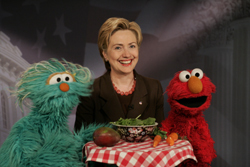
Elmo is a red Muppet character on the children's television show Sesame Street. A furry red monster who speaks in a high-pitched falsetto voice and frequently refers to himself in the third person, he hosts the last full five-minute segment on Sesame Street, "Elmo's World", which is aimed at toddlers. He was originally performed by Kevin Clash. Following Clash's resignation in late 2012, Elmo has been performed by Ryan Dillon.
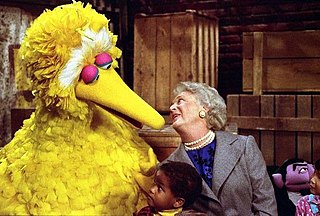
Big Bird is a Muppet character designed by Jim Henson and built by Kermit Love for the children's television show Sesame Street. An eight-foot-two-inch-tall (249 cm) bright yellow anthropomorphic bird, he can roller skate, ice skate, dance, swim, sing, write poetry, draw, and ride a unicycle. Despite this wide array of talents, he is prone to frequent misunderstandings, on one occasion even singing the alphabet as a single word. He would refer to grocer Mr. Hooper as "Mr. Looper", among other mispronunciations. He lives in a large nest behind the 123 Sesame Street brownstone and right next to Oscar the Grouch's trash can. In Season 46, the nest sits within a small, furnished maple tree, and is no longer hidden by used construction doors. He has a teddy bear named Radar.
Guy Smiley is a fictional character on Sesame Street who was dubbed "America's favorite game show host". His skits are among those on the show that parody commercial media. Smiley has also hosted This Is Your Lunch and Here Is Your Life, a parody of This Is Your Life. Guests who were profiled included a loaf of bread, a tooth and a tree. He has also hosted pageants for numbers and letters.

"Mary Had a Little Lamb" is an English language nursery rhyme of nineteenth-century American origin, first published by American writer Sarah Josepha Hale in 1830. It has a Roud Folk Song Index number of 7622.

Christmas Eve on Sesame Street is a Sesame Street Christmas special first broadcast on PBS on Sunday, December 3, 1978.
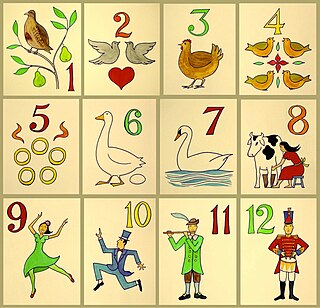
A cumulative song is a song with a simple verse structure modified by progressive addition so that each verse is longer than the verse before. Cumulative songs are popular for group singing, in part because they require relatively little memorization of lyrics, and because remembering the previous verse to concatenate it to form the current verse can become a kind of game.

Sesame Place Philadelphia is a children's theme park and water park based on the children's educational television program Sesame Street. It is one of the two Sesame Place theme parks owned and operated by United Parks & Resorts under an exclusive license from Sesame Workshop, the non-profit owner of Sesame Street. Located outside of Philadelphia in Middletown Township, Bucks County, Pennsylvania, it is the older of the two Sesame Street theme parks in the United States. Sesame Place Philadelphia includes a variety of rides, shows and water attractions suited for young children, and is the first theme park in the world to become a certified autism center.
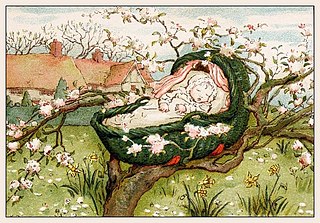
"Rock-a-bye baby on the tree top" is a nursery rhyme and lullaby. It has a Roud Folk Song Index number of 2768.

It's a Big Big World is an American children's television series that aired on PBS Kids from January 2, 2006, to January 8, 2010. The series was created by Mitchell Kriegman, the creator of the Muppet television series Bear in the Big Blue House. After the series ended, reruns continued to air until April 30, 2010. The show revolves around a group of animals living in "The World Tree" in the rainforest along the Amazon River with the Brazilian highest mountain Pico da Neblina as the mountain background. The main character and host is Snook the sloth.
"Row, Row, Row Your Boat" is an English language nursery rhyme and a popular children's song, of American origin, often sung in a round. It has a Roud Folk Song Index number of 19236.
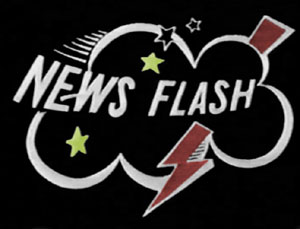
The Sesame Street News Flash is a recurring segment on the children's television show Sesame Street. First aired in 1972, the series starred Kermit the Frog as a trench coat-dressed roving reporter who interviews Muppet versions of characters from fairy tales, Mother Goose nursery rhymes and key moments in history.

"The Twelve Days of Christmas" is an English Christmas carol. A classic example of a cumulative song, the lyrics detail a series of increasingly numerous gifts given to the speaker by their "true love" on each of the twelve days of Christmas. The carol, whose words were first published in England in the late eighteenth century, has a Roud Folk Song Index number of 68. A large number of different melodies have been associated with the song, of which the best known is derived from a 1909 arrangement of a traditional folk melody by English composer Frederic Austin.

Wimzie's House is a half-hour Canadian children's TV program produced in Montreal which ran in the French language as La Maison de Ouimzie on Télévision de Radio-Canada in the morning and Radio-Québec in late afternoons beginning September 4, 1995, and in English on CBC Television in Canada beginning October 21, 1996 and in the U.S. on PBS from September 1, 1997 until August 31, 2001. The show produced by Quebec-based Cinar, with PBS airings presented by Maryland Public Television from 1997 until 2001. The show's puppetry is in the style of Sesame Street, which led to some legal troubles with The Jim Henson Company in 2000.
"Can You Tell Me How to Get to Sesame Street?" is the theme song of the children's television series Sesame Street. It is the oldest song in Sesame Street's history, dating back to the show's beginning on November 10, 1969, and has been used as the title song in every episode of the show.
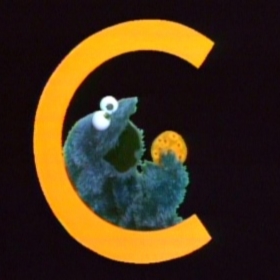
Cookie Monster is a blue Muppet character on the PBS/HBO children's television show Sesame Street. He is best known for his voracious appetite and his famous eating catchphrases, such as "Me want cookie!" As his name suggests, his preferred food is cookies, though he eats almost anything, including inedible objects. Chocolate chip cookies are his favorite kind. His speech is often grammatically nonstandard; for example, he always uses "Me" to refer to himself in place of "I", "My", and "Mine". Despite his voracious appetite for cookies, Cookie Monster shows awareness of healthy eating habits for young children and also enjoys fruit and vegetables.
Joseph Mazzarino is an American puppeteer, writer, director and actor. He is best known for his roles on Sesame Street as Murray Monster, Stinky the Stinkweed and other Muppets, and being Head Writer and Director on Sesame Street, winning 22 Emmy Awards for his work.
Come Follow Me may refer to:











